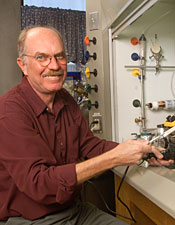Dave Ball
- Email: dball@csuchico.edu
- Phone: 530-898-6496
About
Dave Ball was born on Oct. 22, 1943 in Salt Lake City, Utah. He attended University of California, Berkeley where he participated in undergraduate research under the tutelage of Dr. Donald Noyce (deceased). During his undergraduate career he worked for Ortho Chemical Company in Richmond as a laboratory technician. He graduated with a BS in chemistry in 1966. He pursued graduate work at the University of California at Santa Barbara working with Dr. Dominic Bertelli on the synthesis of a bridged aromatic compound, 1,5-methanoazulene, intended to clarify the extent of aromaticity in non-benzenoid compounds. He received his PhD in 1970. Ball continued his training as a postdoctoral fellow in the laboratories of Dr. William Gensler (deceased) at Boston University working on the synthesis of carbon nucleosides (1970-1). After a year in Boston, he accepted a position as a visiting professor of chemistry at the University of Chile, School of Mathematics and Science in Santiago, Chile (1971-2) through the auspices of the organization of American States. Returning to the United States, he spent two years (1972-4) in a teaching-research post-doctoral position at UC, Santa Barbara working with Professor Clifford Bunton.
In 1974 Ball joined the faculty at California State University, Chico. He has taught general chemistry, lecture and lab; organic chemistry, lecture and lab; physical organic chemistry; spectroscopy; and synthetic organic chemistry, lecture and lab. Most recently he has worked with Dr. Randy Miller to develop and implement a new integrated laboratory sequence to replace the traditional physical, analytical, inorganic, and advanced organic laboratories. His research in synthetic organic chemistry during his tenure at Chico State has included more than 50 students as co-workers. For his excellence in teaching and significant contributions to chemistry, Ball was awarded a Professional Achievement Honor by the University in 2005.
Research
Since the summer of 2006, I and my undergraduate student co-workers have been working on various aspects of the total non-racemic synthesis of Lyngbyatoxin A, and analogs thereof.
Lyngbyatoxin A is a marine natural product isolated from the Hawaiian variant of Lyngbya Majuscula Gomont.1 This compound is one of the lyngbyatoxin family, an unusual class of inflammatory and vesicatory substances. These indole alkaloids have attracted substantial biological interest because they are potent activators of protein kinase C (PKC). This enzyme system plays a key role in cellular signal transduction and therefore in the elicitation of intracellular responses induced by external agents such as drugs and hormones. Malfunction of PKC can lead to tumor development and diabetic complications. Selective activators and inhibitors of PKC are promising targets of medicinal chemistry for use as tools for drug development.
One of our current synthetic goals include the production of analogs of indolactam V in conjunction with the Edwards research group.
We are also investigating a 1,4-conjugative addition sequence to generate the quaternary stereocenter non-racemically present in Lyngbyatoxin A (shown below).
A third aspect of the Lyngbyatoxin A project is the elaboration to indolactam V and its analogs of one of several intermediates already synthesized. This sequence, in conjunction with a previously described one about generating the quaternary stereocenter, should provide a versatile total, non-racemic synthesis of our target molecule Lyngbyatoxin A.

